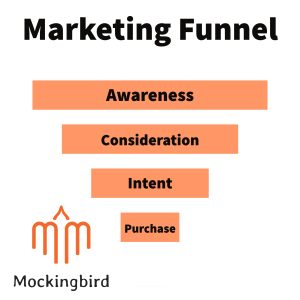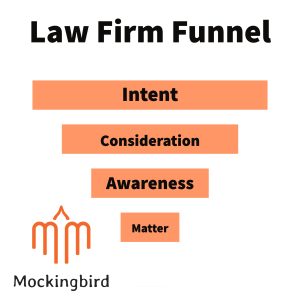What is the Marketing Funnel and How Can Law Firms Use It?
Hey, I’m Tyler, and while I’m new(ish) to Mockingbird, I have a decade of experience in the marketing world, both traditional and digital. I have worked on all types of campaigns from national to local, spanning across multiple verticals and markets. My expertise lies specifically within lead generation. But before we dive in, it is important for us to define the basic marketing sales funnel.
The Funnel
You have probably heard or come across some variation of the marketing funnel (or sales funnel) when researching different ways to market your firm. In a sentence, the funnel allows you to visualize the path your customers take from discovering your brand to becoming a matter. It helps you understand, plan, and strategize your marketing and advertising tactics.
Let’s explore each phase of the traditional funnel in a little more detail.
- Awareness
- Interest/Consideration
- Intent
- Purchase

Before we flip this funnel upside down and side to side to show how it works for law firms, let’s explore each stage of the funnel and how it works from a traditional business and sales perspective.
Awareness – Do your customers know who you are?
What is your brand equity? Do consumers know who you are and what you do? Have they used your service before? Answering these questions is the first step in acquiring new business. Most consumer products are low cost and low risk, so eCommerce and retail locations convert users to customers more cheaply, efficiently and in a much higher quantity. Their customers become aware and can move all the way through the funnel in a single session or visit (think Facebook ad for shoes). This happens because the decision and the overall cost to the user is low and, of course, they want the item. Typically an impulse purchase.
Hiring an attorney is not a “What the hell, I’ll buy those shoes!” transaction. People who are in the market for an attorney will likely shop around and research for a few weeks or more before making a decision. Rarely do law firms see immediate conversions from an initial web session (or billboard or TV commercial). It’s a big decision, and therefore, a process. With legal we know the user likely knows a lawyer is expensive and rarely do they have a positive reason for hiring you. These factors create much more friction of the bat in the funnel for law firms.
I look at it the same way I look at other service based industries. Let’s use HVAC as an example. I can watch commercials all day long or see a Facebook ad promoting the brand and not even consider purchasing. Whereas I could see a Pizza Hut commercial and immediately pick up the phone or log in to their app and order a pizza. Why? Because before I buy an HVAC unit for $20k, no matter how much I want it, I’m going to think about it and consider all my options.
Just like with personal injury, I may see a bus advertisement everyday for five years for “1-800-accident” and then suddenly that very bus hits my car and I injure my back. Boom, I am now unexpectedly in the market. Because of the spontaneity of when someone is in the market for an attorney, it is difficult to drive conversions at the same frequency and volume of a retail or eCommerce shop. As a result, when you are looking for DIY marketing and advertising campaign resources, most of the literature out there refers to eCommerce or retail, thus creating expectations and goals that are unattainable.
This example is extreme, but it perfectly illustrates how we need to look at marketing for law firms. Yes, awareness is important but it isn’t going to drive business to your firm today or this year.
Interest and Consideration – Do people care about your product and would they ultimately buy it?
You can look at these stages of the funnel in a few different ways. Ultimately, we want to know if the people who see your content are interested. If they are interested, they may fill out a form, call-in, or chat through your website. But in most cases we likely won’t know for sure until they visit our site or engage with your social profiles. Once we have collected those users in a remarketing list and segment them out, we can then reach them again with more personalized ads that leads to more valuable actions on site. This is where remarketing comes in… Remarketing is a very powerful tool in building and creating interest after the fact. Email newsletters and offerings are also valuable.
The adage of “You never get a second chance to make a first impression” could not ring more true for brands. This stage is particularly important for brands like Apple, Microsoft, and so on. Yes, a large portion of their customer loyalty comes from them creating a closed ecosystem of products, but they also have earned that loyalty by establishing confidence in their consumers about their brand.
For law firms, this stage is a bit different, but we can apply the same philosophy that big brands use to guide our own strategy. We still want to capture people’s attention, even though they may not be buying now or in the immediate future, but we want to leave a lasting impression that brings us top of mind for when that person is in-market.
Intent – Am I ready to sign a retainer?
It’s time to start the decision-making process. The intent stage is where consumers have decided they are going to buy. For brands like Amazon, this is a forgone conclusion. Rarely does Amazon lose a sale after a consumer has proceeded to checkout.
Law firms, however, have many more hurdles they have to jump. There are consultations (which even if the consumer wants to buy, you aren’t selling to them). Then the agreements/fees and paperwork, which means you as the law firm are ready, but as we all know too well, this is rarely a done deal. There is plenty of friction between accepting a case and your potential client actually signing on the dotted line and forking over the cash to retain you.
Matter
This stage of the funnel speaks for itself. Did they become a matter? However, even this stage can muddy the waters for law firms. Again, like the Amazon model, a consumer checks out, receives shipping notification and their purchase is on the doorstep a few days later. As attorneys, you know that just because they signed and/or paid their fees, the intake process can be a hill to climb in and of itself.
NOW, LET’S TURN THIS THING UPSIDE DOWN AND LOOK AT THE FUNNEL FOR LAW FIRMS.
This is my revised model of the funnel specifically for law firms:
- Intent
- Interest/Consideration
- Awareness
- Matter

Intent
The marketing funnel for law firms starts with when a user has defined themselves as in-market, the intent is there from the beginning. Because legal services are on a “do i need this now” basis, it can be difficult to rise above the noise until a consumer is in-market for legal services.
The cool thing about having a niche service area like law firms is that each of your prospective clients have already pre-qualified themselves as either needing an attorney or needing advice from an attorney by searching for topics related to your practice area. The vast majority of law firms’ leads come from organic search results or search ads. Being seen when a consumer is in the market for your services (within the legal industry this can be immediate and come with a sense of urgency) is where 99% of your conversions will come from. Google Business Profile, Local Service Ads, Paid Search Ads, and regular organic search results for your website are how these consumers will find you and what they will use to determine if you are the right fit for them. However, immediate conversion can happen but oftentimes is rare, primarily dependent upon the type of law you practice.
Interest/Consideration
Interest/Consideration phase comes after the initial exposure to your firm. The user is weighing their different options. At this point they are doing their research and discovering other firms that could help them. Why should they choose yours? What you communicate with your website is paramount to whether or not the user calls or submits a form. As we all know, not every call or form submission will always be 100% qualified (as in right lead for your firm, and in some instances they are spam or marketing folks). At this point they will likely continue researching and weighing the pros and cons of different firms. This is why we need to continue to make sure we able to recapture the user after the first touch (if they don’t convert on this initial visit)
Awareness
Awareness. Let’s make sure we stay top of mind. Let’s make sure every time they search for another attorney or your specific type of practice your firm is still visible. If we are not going to procure business on the first touch, we need to get some stuff in return. An email address, a phone number, anything that allows us to contact them or use to retarget them in the future. Your first touch may be GMB, but the final conversion may come from a search ad or a direct visit to your domain. It is so crucial to keep your firm top of mind during the few weeks a potential client is in the market.
Matter
From here you and your intake team will put each lead through your own qualification process and make sure they have a case or can afford you etc. You have your own internal funnel for weeding out the poor leads.
In conclusion,
Each firm will require some degree of a custom-tailored strategy, but each will likely follow this same model. Your money will be most effectively spent on the platforms, tools and tactics that drive the most qualified leads, most efficiently. Some attorneys might find most of their success through paid means, others may find it primarily through SEO or a combination of the two.. The next step in utilizing this model effectively is knowing where your leads come from, but more importantly where your clients come from. Check out our AWESOME article about Hubspot for Lawyers to level your firm up and really track like a pro.